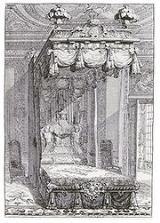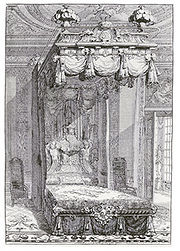
Daniel Marot
Encyclopedia
Daniel Marot was a French
Protestant, an architect
, furniture
designer and engraver at the forefront of the classicizing Late Baroque
"Louis XIV" style.
Born in Paris
, he was a pupil of Jean Le Pautre
and the son of Jean Marot (1620–1679), who was also an architect and engraver. Marot was working independently as an engraver from an early age, making engravings of designs by Jean Bérain
, one of Louis XIV's official designers at the Manufacture des Gobelins, where far more than tapestry
was being produced. The family were Huguenot
s and were part of the wave of émigrés who left France in the year of the Edict of Fontainebleau
and Revocation of the Edict of Nantes (1685) to settle in Holland. Daniel Marot brought the fully developed court style of Louis XIV to Holland, and later to London. In the end, the English style which is loosely called "William and Mary" owed much to his manner.
In the Netherlands Marot was employed by the Stadthouder, who later became William III of England
; in particular, he is associated with designing interiors in the palace of Het Loo
, from 1684 on. Though his name cannot be attached to any English building (and he doesn't have an entry in Howard Colvin
's exhaustive Dictionary of British Architects) we know from his own engraving that he designed the great hall of audience for the States-General at the Hague. He also decorated many Dutch country-houses.
 In 1694, he traveled with William to London
In 1694, he traveled with William to London
, where he was appointed one of his architects and Master of Works. In England his activities appear to have been concentrated at Hampton Court Palace
, where he designed the garden
parterre
s, which were swept away in the following generation and have been restored at the end of the 20th century. Much of the furniture, especially the mirrors, gueridons and state beds, in the new State Rooms readied for William at Hampton Court bears unmistakable traces of his authorship; the tall and monumental embroidered state beds, with their plumes of ostrich feathers, their elaborate valances and cantonnieres agree very closely with his later published designs (illustration, right).
In his engraved
designs, Marot's range was extraordinarily wide. He designed practically every detail in the internal ornamentation of the house: carved chimneypieces, plaster ceilings, panels for walls, girandoles and wall brackets, and side tables with their pairs of tall stands. He designed gold and silver plate. The craze for collecting china which was at its height in his time is illustrated in his lavish designs for receptacles for porcelain: in one of his plates there are more than 300 pieces of china on the chimney-piece alone.
After William's death Marot returned to Holland, in 1698, where he lived out his life. We owe much of our knowledge of his work to the folio volume of his furniture designs published at Amsterdam in 1712. Not surprisingly the designs show strong French and Dutch influences; what reads as their "English" look is more probably the result of Marot's court style on other London designers.
France
The French Republic , The French Republic , The French Republic , (commonly known as France , is a unitary semi-presidential republic in Western Europe with several overseas territories and islands located on other continents and in the Indian, Pacific, and Atlantic oceans. Metropolitan France...
Protestant, an architect
Architect
An architect is a person trained in the planning, design and oversight of the construction of buildings. To practice architecture means to offer or render services in connection with the design and construction of a building, or group of buildings and the space within the site surrounding the...
, furniture
Furniture
Furniture is the mass noun for the movable objects intended to support various human activities such as seating and sleeping in beds, to hold objects at a convenient height for work using horizontal surfaces above the ground, or to store things...
designer and engraver at the forefront of the classicizing Late Baroque
Baroque
The Baroque is a period and the style that used exaggerated motion and clear, easily interpreted detail to produce drama, tension, exuberance, and grandeur in sculpture, painting, literature, dance, and music...
"Louis XIV" style.
Born in Paris
Paris
Paris is the capital and largest city in France, situated on the river Seine, in northern France, at the heart of the Île-de-France region...
, he was a pupil of Jean Le Pautre
Jean le Pautre
Jean le Pautre was a French designer and engraver. Le Pautre was an apprentice to a carpenter and builder. In addition to learning mechanical and constructive work, he developed considerable skill with the pencil...
and the son of Jean Marot (1620–1679), who was also an architect and engraver. Marot was working independently as an engraver from an early age, making engravings of designs by Jean Bérain
Jean Bérain the Elder
Jean Berain the Elder was a draughtsman and designer, painter and engraver of ornament, the artistic force in the Royal office of the Menus-Plaisirs du Roi where all the designs originated for court spectacle, from fêtes to funerals, and many designs for furnishings not covered by the Bâtiments du...
, one of Louis XIV's official designers at the Manufacture des Gobelins, where far more than tapestry
Tapestry
Tapestry is a form of textile art, traditionally woven on a vertical loom, however it can also be woven on a floor loom as well. It is composed of two sets of interlaced threads, those running parallel to the length and those parallel to the width ; the warp threads are set up under tension on a...
was being produced. The family were Huguenot
Huguenot
The Huguenots were members of the Protestant Reformed Church of France during the 16th and 17th centuries. Since the 17th century, people who formerly would have been called Huguenots have instead simply been called French Protestants, a title suggested by their German co-religionists, the...
s and were part of the wave of émigrés who left France in the year of the Edict of Fontainebleau
Edict of Fontainebleau
The Edict of Fontainebleau was an edict issued by Louis XIV of France, also known as the Revocation of the Edict of Nantes. The Edict of Nantes of 1598, had granted the Huguenots the right to practice their religion without persecution from the state...
and Revocation of the Edict of Nantes (1685) to settle in Holland. Daniel Marot brought the fully developed court style of Louis XIV to Holland, and later to London. In the end, the English style which is loosely called "William and Mary" owed much to his manner.
In the Netherlands Marot was employed by the Stadthouder, who later became William III of England
William III of England
William III & II was a sovereign Prince of Orange of the House of Orange-Nassau by birth. From 1672 he governed as Stadtholder William III of Orange over Holland, Zeeland, Utrecht, Guelders, and Overijssel of the Dutch Republic. From 1689 he reigned as William III over England and Ireland...
; in particular, he is associated with designing interiors in the palace of Het Loo
Het Loo
Het Loo Palace is a palace in Apeldoorn, Netherlands. The symmetrical Dutch Baroque building was designed by Jacob Roman and Johan van Swieten and was built between 1684 and 1686 for stadtholder-king William III and Mary II of England...
, from 1684 on. Though his name cannot be attached to any English building (and he doesn't have an entry in Howard Colvin
Howard Colvin
Sir Howard Montagu Colvin, CVO, CBE , was a British architectural historian who produced two of the most outstanding works of scholarship in his field.-Life and works:...
's exhaustive Dictionary of British Architects) we know from his own engraving that he designed the great hall of audience for the States-General at the Hague. He also decorated many Dutch country-houses.

London
London is the capital city of :England and the :United Kingdom, the largest metropolitan area in the United Kingdom, and the largest urban zone in the European Union by most measures. Located on the River Thames, London has been a major settlement for two millennia, its history going back to its...
, where he was appointed one of his architects and Master of Works. In England his activities appear to have been concentrated at Hampton Court Palace
Hampton Court Palace
Hampton Court Palace is a royal palace in the London Borough of Richmond upon Thames, Greater London; it has not been inhabited by the British royal family since the 18th century. The palace is located south west of Charing Cross and upstream of Central London on the River Thames...
, where he designed the garden
History of gardening
The history of ornamental gardening may be considered as aesthetic expressions of beauty through art and nature, a display of taste or style in civilized life, an expression of an individual's or culture's philosophy, and sometimes as a display of private status or national pride—in private...
parterre
Parterre
A parterre is a formal garden construction on a level surface consisting of planting beds, edged in stone or tightly clipped hedging, and gravel paths arranged to form a pleasing, usually symmetrical pattern. Parterres need not have any flowers at all...
s, which were swept away in the following generation and have been restored at the end of the 20th century. Much of the furniture, especially the mirrors, gueridons and state beds, in the new State Rooms readied for William at Hampton Court bears unmistakable traces of his authorship; the tall and monumental embroidered state beds, with their plumes of ostrich feathers, their elaborate valances and cantonnieres agree very closely with his later published designs (illustration, right).
In his engraved
Engraving
Engraving is the practice of incising a design on to a hard, usually flat surface, by cutting grooves into it. The result may be a decorated object in itself, as when silver, gold, steel, or glass are engraved, or may provide an intaglio printing plate, of copper or another metal, for printing...
designs, Marot's range was extraordinarily wide. He designed practically every detail in the internal ornamentation of the house: carved chimneypieces, plaster ceilings, panels for walls, girandoles and wall brackets, and side tables with their pairs of tall stands. He designed gold and silver plate. The craze for collecting china which was at its height in his time is illustrated in his lavish designs for receptacles for porcelain: in one of his plates there are more than 300 pieces of china on the chimney-piece alone.
After William's death Marot returned to Holland, in 1698, where he lived out his life. We owe much of our knowledge of his work to the folio volume of his furniture designs published at Amsterdam in 1712. Not surprisingly the designs show strong French and Dutch influences; what reads as their "English" look is more probably the result of Marot's court style on other London designers.
External reference
- Life and Design Examples
- Das Ornamentwerk des Daniel Marot: in 264 Lichtdrucken nachgebildet, 1892 at the University of Heidelberg.

